For the primary care research projects active in 2021 and 2022 (128 grants and 12 contracts), AHRQ has invested a total of $220.8 million across the multiple years of grant funding (spanning fiscal years 2016-2027). This included $199.8 million for grants and $21.0 million for contracts.
In 2021 and 2022 alone, AHRQ committed $99.4 million to new primary care research projects that will continue into 2027 (including $92.5 million for grants and $6.9 million for contracts). This funding included:
- $2 million in funding from the first NCEPCR appropriation made in fiscal year 2022 (including $0.5 million in grants and $1.5 million in contracts).
- $42.8 million in funding from the Patient-Centered Outcomes Research Trust Fund (PCORTF) (including $39.6 million in grants and $3.2 million in contracts).
- $22.6 million in funding from General Health Services Research appropriation (including $20.4 million in grants and $2.2 million in contracts).
- $21.6 million in grant funding from Patient Safety appropriation.
- $6.7 million in grant funding from Digital Healthcare Research appropriation.
- $3.7 million in grant funding from the COVID-19 appropriation.
This investment supports a large body of work that is leading to significant impacts on primary care and progress on behalf of the American public.
In this section of the report, we provide analysis across the 128 grants and 12 contracts identified as primary care research projects, to better understand this body of work and AHRQ's investment. (Go to About This Report for the definition of primary care relevant research, and details about how we identified this list of projects).
Primary Care Grants and Cooperative Agreements
There were a total of 128 primary care related grants and cooperative agreements with active AHRQ funding during fiscal years (FYs) 2021 and 2022. Of these, 124 were unique, 2 were for additional funding to existing grants to answer questions related to COVID, and 2 were non-competing continuations of existing grants. Below we describe the distribution of grants and cooperative agreements (from here on referred to collectively as "grants") by funding mechanism, awardee institutions, topic areas, and other attributes.
Funding Mechanisms
Of AHRQ's 124 unique primary care grants, 120 were research focused and 4 were conference grants. Of the 120 research focused grants, 13 (or 10%) were career development or “K” awards and 2 grants were R36 Dissertation Awards. The specific funding mechanism and the number of each type are shown in Exhibit 1.
Exhibit 1. Number and Percentage of Primary Care Grants, by Mechanism (N = 124)
| Code | Funding Mechanism Name (1) | # | % |
|---|---|---|---|
| Research | |||
| R01 | Research Project | 41 | 33% |
| R18 | Research Demonstration and Dissemination Project | 38 | 31% |
| U18 | Research Demonstration/Cooperative Agreement | 13 | 10% |
| R03 | Small Research Project Grant | 7 | 6% |
| R21 | Exploratory/Developmental Research Grant | 6 | 5% |
| R36 | Dissertation Award | 2 | 2% |
| Career Development | |||
| K08 | Mentored Clinical Scientist Development Award | 8 | 6% |
| K01 | Research Career Programs | 4 | 3% |
| K18 | Research Career Enhancement Award for Established Investigators | 1 | 1% |
| Conference | |||
| R13 | Support for Conferences and Scientific Meetings | 4 | 3% |
| Total | 124 | 100% | |
The proportion of grants by funding mechanism, after both career development grants and conference grants have been removed, is depicted in Exhibit 2.
Exhibit 2. Proportion of Research Grants by Mechanism (N=107)
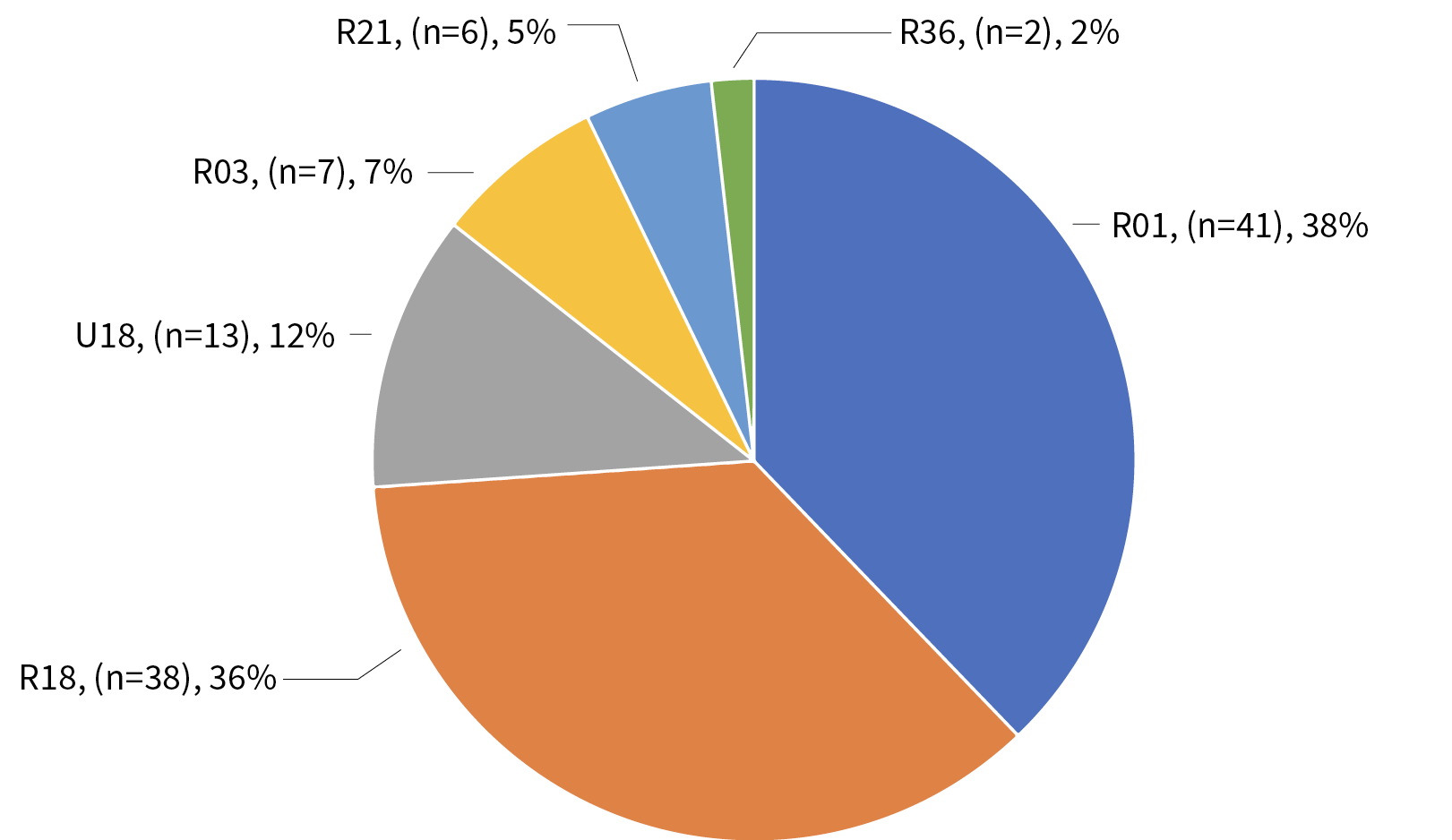
The 124 grants were distributed across 66 institutions located in 30 states across the country. The map in Exhibit 3 depicts the distribution of awards across the U.S., with the size of the dots on the map indicating the number in a particular area.
Exhibit 3. Map of Grant Recipients*
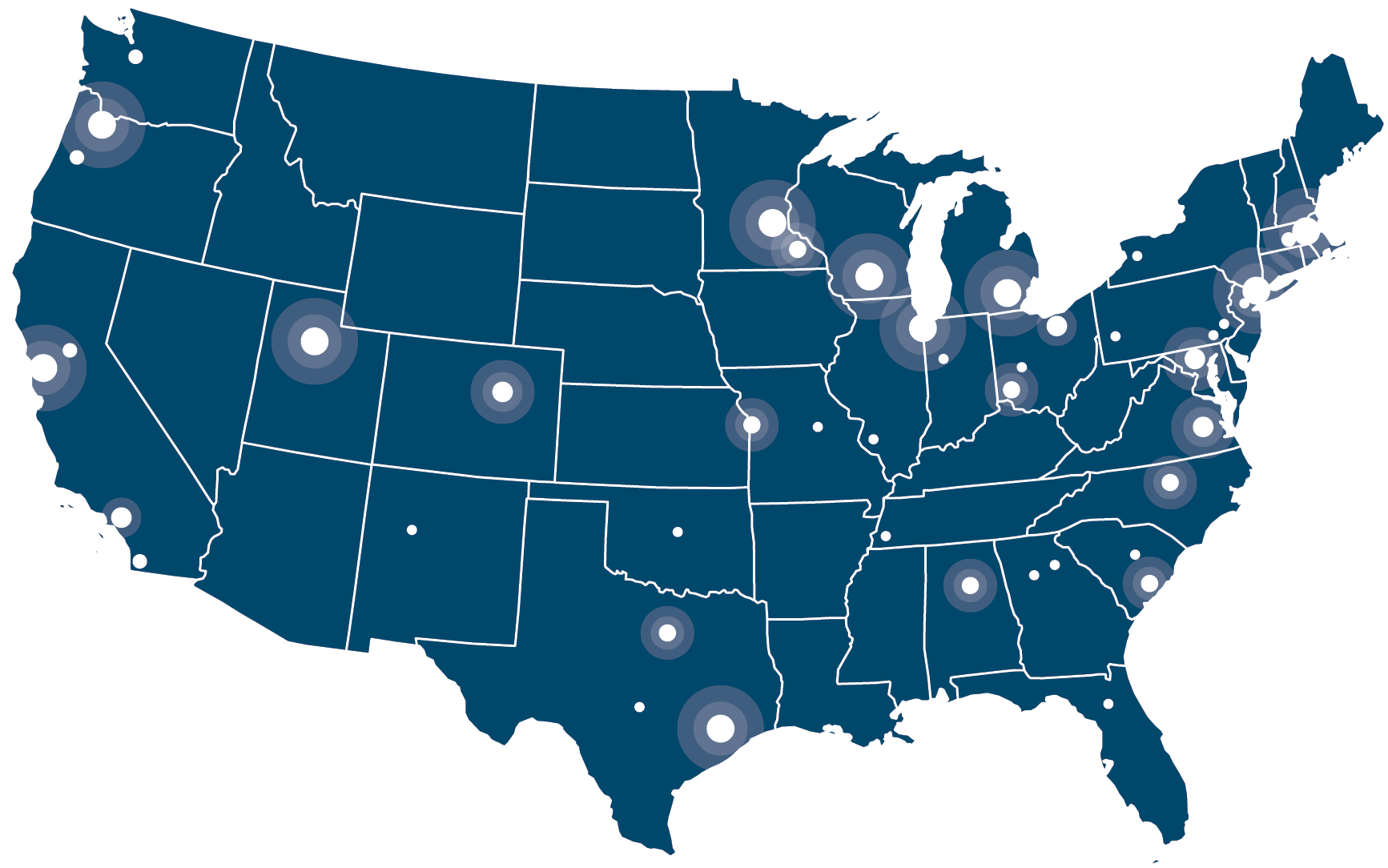
*Dots indicate grants by zip code, where larger dots equal a greater number of grants in the area.
Among the institutions that received AHRQ grants (as depicted in Exhibit 4, below), we found that the majority (72%) were academic institutions, followed by medical systems (15%), research institutes (9%), and non-profit organizations (5%). Of the academic institutions, 69% were public, and 31% were private.
Exhibit 4. Awardee Types (N=124)
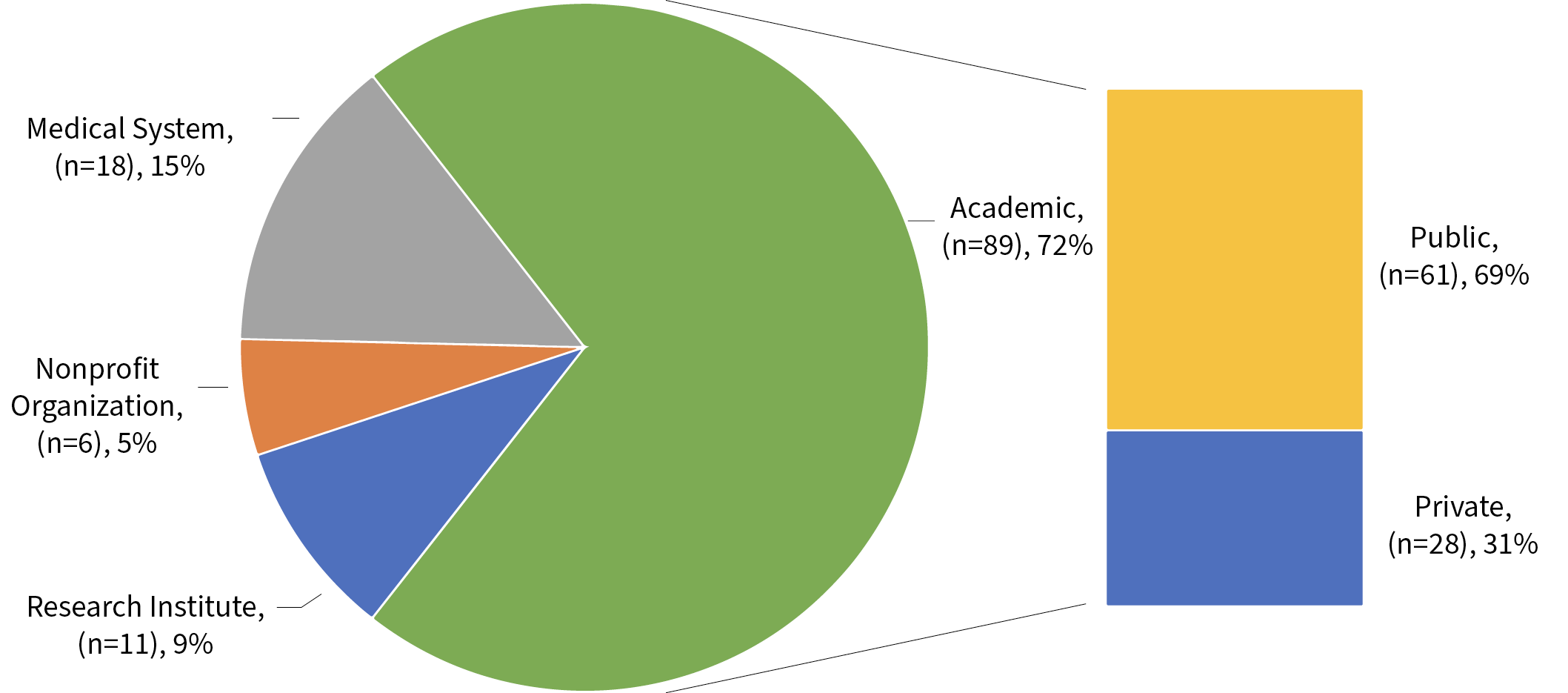
Almost half of the 66 institutions held more than one AHRQ primary care grant during this period, as shown in Exhibit 5.
Exhibit 5. Grantee Institutions with Multiple Grants (names as shown in grant application)
| Institution Name | # of Grants |
|---|---|
| University of California, San Francisco | 5 |
| University of Wisconsin-Madison | 5 |
| Columbia University Health Sciences | 4 |
| Kaiser Foundation Research Institute | 4 |
| Northwestern University at Chicago | 4 |
| Oregon Health & Science University | 4 |
| University of Michigan at Ann Arbor | 4 |
| University of Minnesota | 4 |
| Virginia Commonwealth University | 4 |
| RAND Corporation | 3 |
| University of Colorado Denver | 3 |
| University of Utah | 3 |
| Albert Einstein College of Medicine | 2 |
| Baylor College of Medicine | 2 |
| Brigham and Women's Hospital | 2 |
| Cincinnati Children's Hospital Medical Center | 2 |
| Harvard Medical School | 2 |
| Massachusetts General Hospital | 2 |
| Mayo Clinic Rochester | 2 |
| Medical University of South Carolina | 2 |
| North American Primary Care Research Group | 2 |
| OCHIN, Inc. | 2 |
| Stanford University | 2 |
| University of Alabama at Birmingham | 2 |
| University of California at Davis | 2 |
| University of California, San Diego | 2 |
| University of Massachusetts Medical School, Worcester | 2 |
| University of North Carolina Chapel Hill | 2 |
| Weill Medical College of Cornell University | 2 |
Topic Areas
Key Topic Areas
To further understand AHRQ’s primary care grants, we categorized each grant across key topic areas of interest to AHRQ, as well as additional areas of focus. When we look at the topic area that best describes each grant, we find that the largest proportion of projects aligned with Practice and Quality Improvement (27%); followed by Healthcare Systems and Infrastructure, including payment (19%); Digital Healthcare (18%); and Person-Centered Care (14%). A smaller proportion of projects primarily aligned with Behavioral Health (7%), Health Equity (6%), Primary Care Workforce (3%), or Public Health and Community Integration (2%). The full distribution across grants is displayed in Exhibit 6.
Exhibit 6. Research Grants by Main Topic Area (N=124)
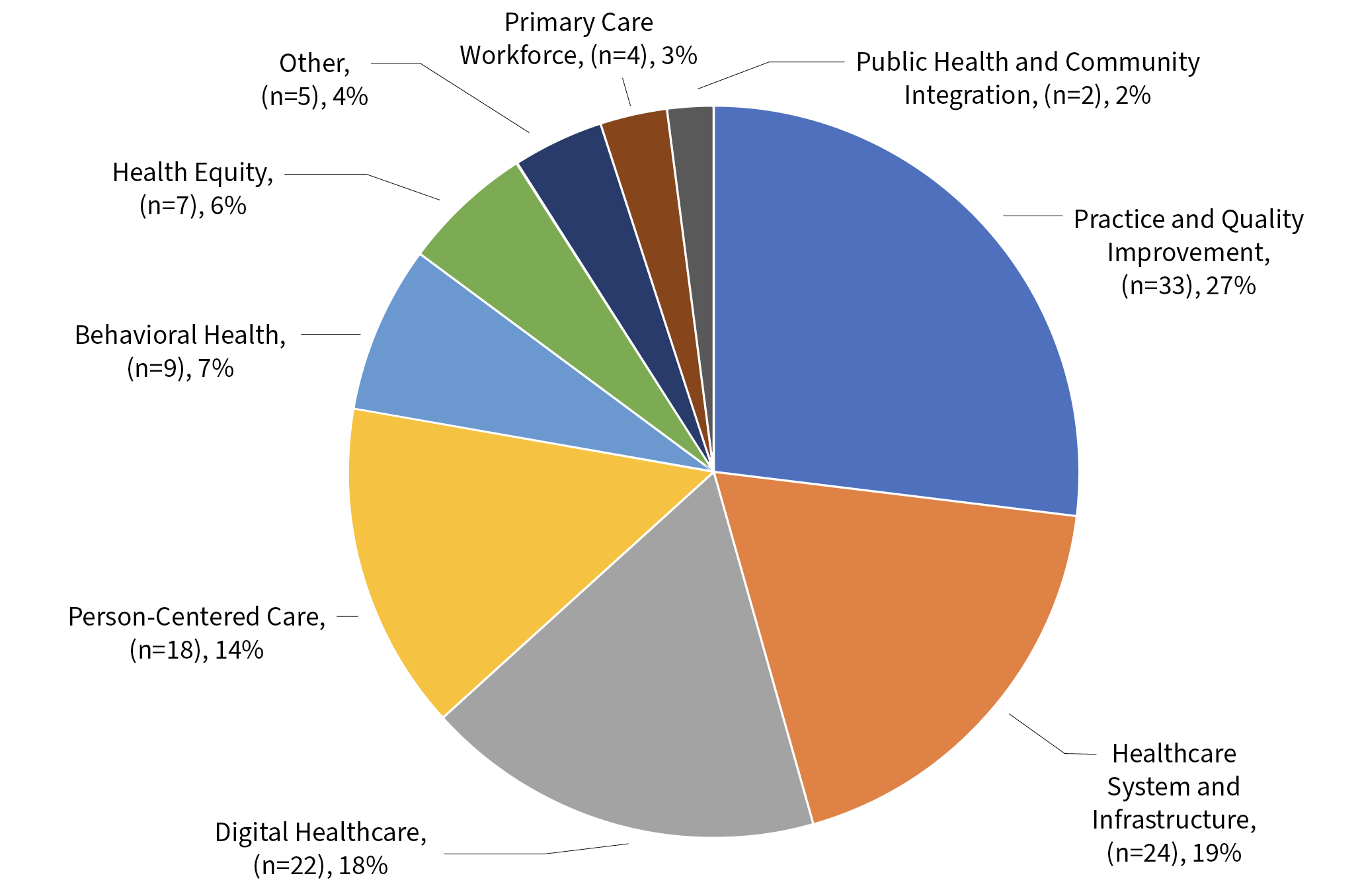
However, most of the grants include some focus on multiple topic areas. When we look at the top three topic areas addressed across each grant, we see a slightly different story, as shown in Exhibit 7. For example, when we look at all of the projects that align with a topic, the largest proportion of projects align with Digital Healthcare (48%), followed closely by Practice and Quality Improvement (44%). We also see that the percentage of grants with a focus on Health Equity went up dramatically (from 6% to 26%). The percentage of grants with a focus on Behavioral Health (14%), Public Health and Community Integration (7%), and Primary Care Workforce (4%) remain low relative to other topic areas. Given AHRQ’s interest in these topics, additional grant funding could be warranted in these areas.
Exhibit 7. Number of Grants by All Topic Areas (N=124)
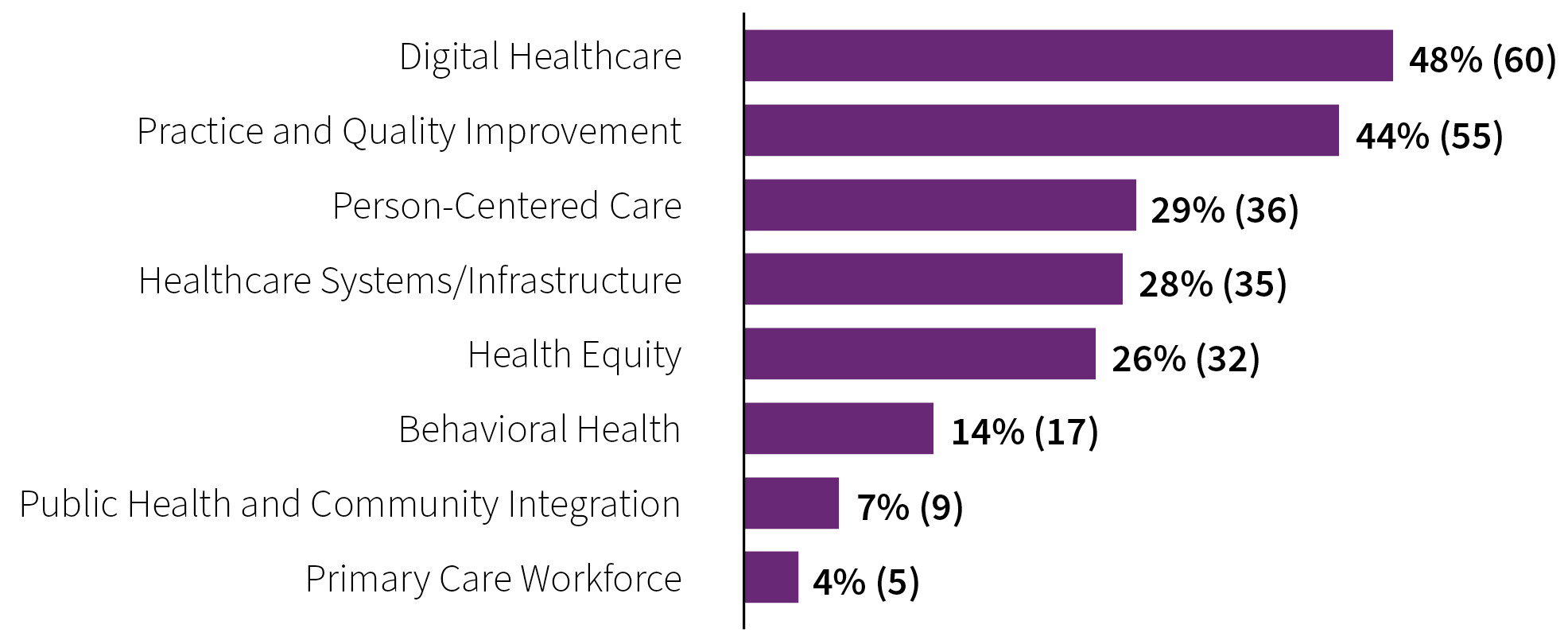
Additional Topic Areas
We also identified several additional areas of focus across the grants, as described in Exhibit 8. A relatively large percentage of grants (24%) were related to Patient Safety, while a similar percentage of grants looked at each of the other additional topic areas.
Exhibit 8. Number of Grants by Additional Areas of Focus (N=124)
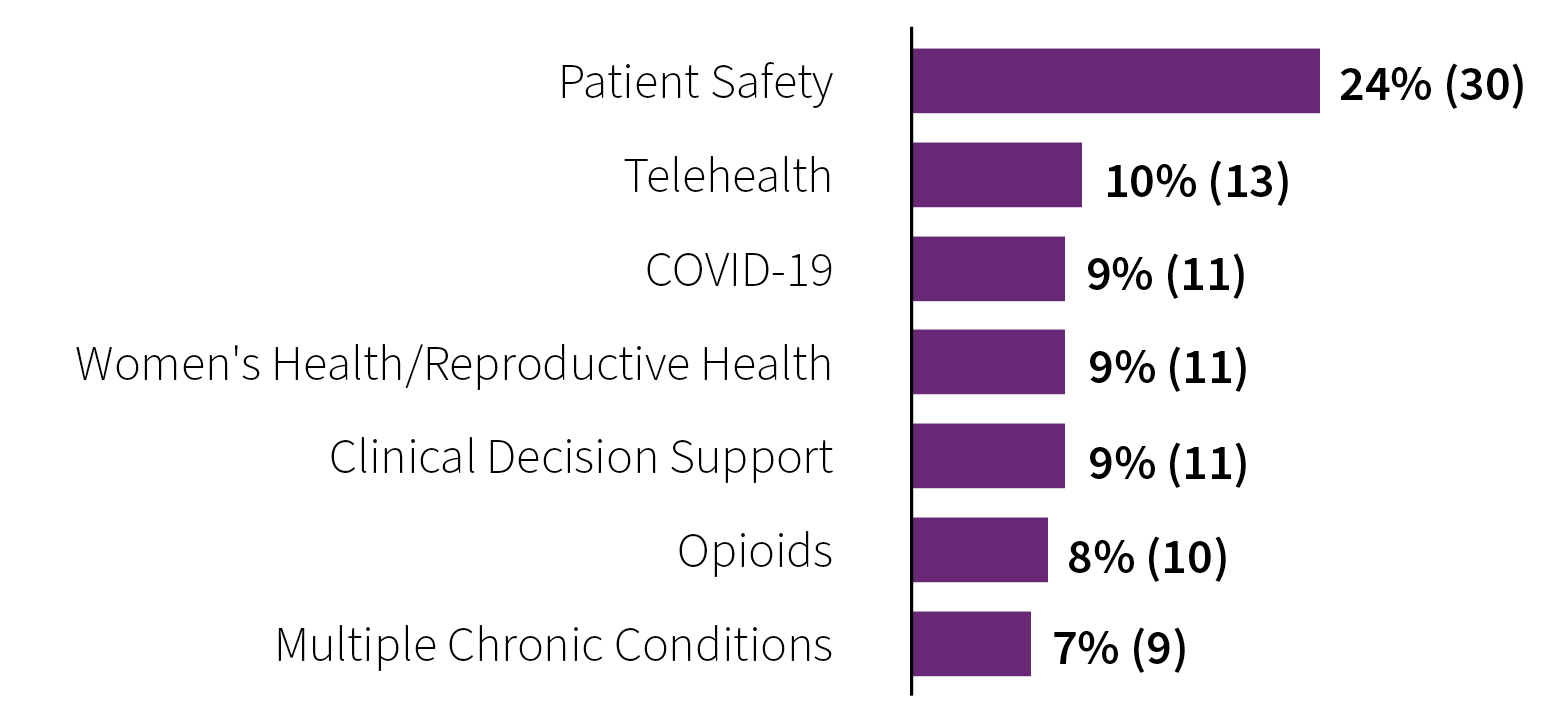
Setting, Geography, and Populations
Finally, we collected information about the practice type, geographical settings (e.g., rural, or urban practices, or region of interest), and patient population for the AHRQ primary care grants. Unfortunately, we did not have this information across grants, so we cannot share precise numbers or compare percentages. However, we can report that the grants researched care provided in a wide range of provider settings, including community health centers; federally qualified health centers; small, independent practices; clinics in large health centers; ambulatory care centers; urgent care centers; community pharmacies; and Veteran's Health Administration facilities. In addition, funded grants studied primary care throughout the U.S. as well as in frontier, rural, and urban geographical settings and in widely diverse patient populations, including children and adolescents; women; older adults; people with limited English proficiency or low literacy; low income or medically underserved populations; people from racial and ethnic minority groups; uninsured people; Medicaid, Medicare, and dual-eligible beneficiaries; Veterans; and clinicians.
Publications
Through National Library of Medicine searches, our team identified 516 published papers acknowledging 82 of the 128 primary care AHRQ grants as of February 2024. Exhibit 9 shows the journals with the most publications from this set.
Exhibit 9. Ten Most Common Journals for Publications from AHRQ Primary Care Grants
| Journal Title | # of Publications |
|---|---|
| Journal of General Internal Medicine | 37 |
| JAMA Network Open | 19 |
| Medical Care | 14 |
| Journal of the American Board of Family Medicine | 9 |
| Journal of the American Geriatrics Society | 9 |
| Diabetes Care | 8 |
| BMJ Open | 8 |
| Health Services Research | 8 |
| JAMA Internal Medicine | 8 |
| Applied Clinical Informatics Journal | 8 |
In addition, AHRQ identified another 100 articles with primary care relevant content from other AHRQ funded sources (e.g., non-primary care grants).
Primary Care Contracts
The 12 primary care related contracts funded by AHRQ in 2021 and 2022 were led by nine organizations, including two universities (Johns Hopkins University and Oregon Health & Science University), five research and consulting firms (Abt Global, National Opinion Research Center [NORC], RAND Corporation, Research Triangle Institute International [RTI], and Westat Inc.), one member association (The Association for Prevention Teaching and Research), and a non-profit society of scholars (National Academy of Sciences). Information about each of these contracts is included in Exhibit 10.
Exhibit 10. AHRQ's Primary Care Related Contracts active during 2021 and 2022
| Contract Title | Contractor | Brief Description of Scope |
|---|---|---|
| Implementing High- Quality Primary Care | National Academy of Sciences | Examine the current state of primary care and develop an implementation plan to strengthen primary care services in the United States and inform primary care systems around the world. |
| Models of Pediatric- Adolescent Cancer Survivorship Care that Include Primary Care | Johns Hopkins University | A large topic refinement with an option for a medium systematic review. |
| Study of State Actions to Improve the Delivery of Primary Care | Research Triangle Institute | Promote an understanding of which state actions have helped improve primary care, what conditions and factors positively and negatively affect the results of state actions, and provide findings and lessons to inform federal initiatives to improve and expand primary care. |
| Strategies for Integrating Behavioral Health and Primary Care | Oregon Health & Science University | Conduct one large topic refinement with pre-award key question posting, and an optional task of one large systematic review with simultaneous peer review and public comment. |
| Patient-Centered Preventive Healthcare: Gathering Stakeholder Input on Evidence and Implementation | Research Triangle Institute | Update the list of high-priority clinical preventive services for adults over the age of 35 through expert consensus and to gather expert input on strategies for the patient-centered implementation of these services as recommended by the U.S. Preventive Services Task Force and Center for Disease Control's Advisory Committee on Immunization Practices. |
| The Academy for Integrating Behavioral Health and Primary Care | Westat, Inc. | Maintain the Academy portal to serve as a national resource hub for the field of integrating behavioral health and substance abuse with primary care. |
| Preventive Medicine and Primary Care Residency Rotation Program | Association For Prevention Teaching and Research | Administer and coordinate a preventive medicine and primary care residency rotation program providing scientific and dissemination support to the U.S. Preventive Services Task Force. |
| Dissemination and Stakeholder Engagement Support for AHRQ's National Center for Excellence in Primary Care Research | Abt Global Inc. | Increase awareness of NCEPCR and AHRQ’s primary care research by engaging stakeholders, providing webinars and events informed by stakeholders’ needs and interests, and producing an annual report to summarize and synthesize AHRQ’s investments in primary care research including dissemination and implementation (D&I) research. |
| EvidenceNOW Contracts | ||
| Assistance to AHRQ to Disseminate EvidenceNOW Findings and Plan for Future Investments in Primary Care Quality Improvement Infrastructure | Abt Global Inc. | Create and update resources, tools, and other communications materials to increase awareness of findings from the EvidenceNOW: Advancing Heart Health initiative; create and implement a plan to disseminate EvidenceNOW findings to key stakeholder groups; and develop recommendations for integrating EvidenceNOW web content with other primary care-related content on AHRQ's website. |
| Supporting and Evaluating the Dissemination and Implementation of PCOR to Increase Screening and Management of Unhealthy Alcohol Use in Primary Care | National Opinion Research Center (NORC) | Technical assistance and evaluation contract to support the EvidenceNOW: Managing Unhealthy Alcohol Use initiative. Includes developing a resource center, convening a technical expert panel, conducting an environmental scan, and facilitating a learning community among the grantees. Additionally, the contractor is conducting an evaluation to assess the performance and impact of the grants. |
| Technical Assistance to and Evaluation of Grant Initiative to Develop State-level Capacity for Dissemination and Implementation of Patient- Centered Outcomes Research into Primary Care | Abt Global | Technical assistance and evaluation contract to support the EvidenceNOW: Building State Capacity initiative. Contractor supports a grant initiative to disseminate and implement PCOR findings in primary care practices and develop sustainable, primary care quality improvement capacity within states by providing communications services to AHRQ and grantees, providing technical assistance to grantees, and conducting an overarching evaluation of the initiative. |
| Improving Nonsurgical Treatment of Urinary Incontinence among Women in Primary Care (INTUIT-PC) Evaluation and Technical Support | RAND Corporation | Technical assistance and evaluation contract to support the EvidenceNOW: Managing Urinary Incontinence initiative. Includes developing resources to support grantees’ success, creating a learning community to support peer-to peer sharing of resources and lessons learned, and evaluating the program’s impact. |
AHRQ has developed many resources and materials to support primary care research and primary care clinician practice, as described in the following sections of this report. Many of these resources were developed through contracts.



